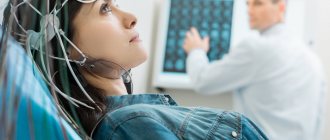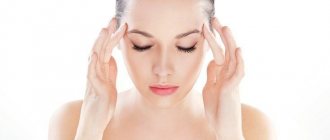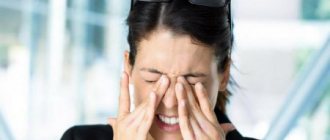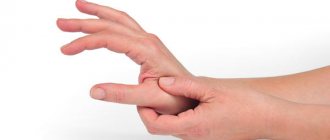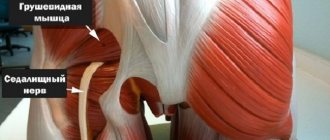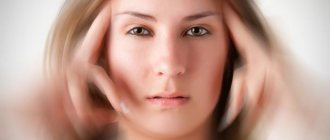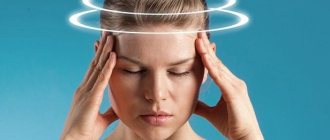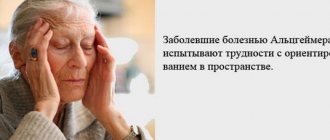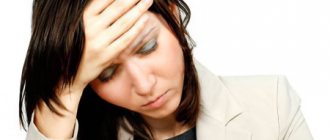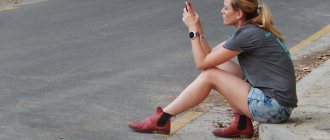Unsteadiness of gait in vascular and autonomic disorders
Often, unsteadiness of gait is directly related to vascular headaches, which manifest themselves against the background of disturbances in cerebral blood flow. Vascular cephalgia is characterized by:
- localization in the occipital part;
- exhausting, strong and throbbing pain radiating to the temples;
- a feeling of unreality, a feeling that the world around is “spinning” and “spinning”;
- visual deviations, including flickering “grid” before the eyes.
Patients complain of a fear of open spaces, an irresistible desire to be near any support. Many people note that before going out they feel a heaviness in the head and muscle tension. Movements become clumsy and uncoordinated. For no apparent reason, the head aches and feels dizzy, and weakness sets in.
Factors influencing instability
Doctors note that uncertainty and swaying while walking with VSD are associated with the following reasons:
- Firstly, with impaired consciousness. Main symptoms: vision becomes cloudy, the surrounding “picture” loses clear outlines and becomes foggy, dizziness, suffocation, and often the person is in a pre-fainting state.
- Secondly, with constant thoughts of being unwell. They create an imbalance in the body. Patients often notice that when they forget about the pathology and their head is “clear,” the unsteadiness disappears.
- Thirdly, with tightness and stiffness of muscle fibers. Why are the muscles tight? Chronic stress, fear, and depression make them this way. The muscle mass of the neck and back tenses, the limbs tremble, the head feels dizzy, and coordination is lost.
How to improve the condition?
It is important to “get to the bottom” of the causes of blood pressure surges, panic attacks, unreasonable fears, etc. After all, the main factors of instability during VSD, fogginess and headaches, vertigo are hidden in the lability of the nervous system, constant stress-anxiety and depressive states.
You should follow the instructions not only of therapists and neurologists, but also contact psychotherapists or psychiatrists with the problem. You will have full information about the causes of the malfunction in the body and know what to do to eliminate the “provocateurs” of the disease. Please note that almost 10% of gait imbalance and head ailments in VSD are associated with thyroid dysfunction and cardiac arrhythmia.
First aid for a sudden deterioration in health
In the event of an attack of dizziness, emergency assistance to any person is required immediately and it is necessary to follow several recommendations:
- The body needs peace and a sense of support (sit down, lie down, or lean on something).
- Pull yourself together and don't panic.
- Try to concentrate on one subject.
- If you are dressed too warmly, or clothing interferes with free breathing, you should remove it (if possible) or facilitate access to fresh air (for example, unbutton your collar).
- If the person is elderly, dentures should be removed.
- If you are in a stuffy room, either go outside or open a window for ventilation.
- If you have a tonometer at hand, be sure to measure your pressure.
- If your health only worsens over time, call an ambulance.
- It is strictly prohibited to take any medications before doctors arrive.
After the ambulance arrives and the doctor examines you, you should strictly follow all the procedures prescribed by him. And then be sure to undergo a medical examination at a clinic to identify the cause of dizziness.
Balance imbalance in cervical osteochondrosis
If the gait becomes stumbling, with “drunk” elements, and at the same time the head is dizzy and noisy, then the pathology may be caused by collar (cervical) osteochondrosis. Unstability, loss of balance and swaying are accompanied by:
- sensation of cotton plugs in the ears;
- aching and lasting cephalalgia, which sharply intensifies with head movements;
- soreness in the neck and face;
- increased heart rate;
- profuse sweating;
- redness or pallor of the epithelium.
Effective ways to improve your condition
It is important to understand that it is impossible to restore a confident gait without treating cervical osteochondrosis, which provokes it. Doctors may prescribe:
- Taking pharmacological agents that dilate and tonic blood vessels, enhancing brain nutrition.
- Do traction and fixation of the collar area, regularly carry out water procedures, and perform a complex (individually selected!) of physical therapy.
- Stick to a diet enriched with vitamins B, C, etc.
A visit to the doctors should not be postponed if the lethargy of the legs is rapidly progressing. It is necessary to conduct a full and comprehensive examination so as not to ignore any anomalies that require immediate surgical intervention. For example, a herniated (prolapsed) intervertebral disc pinching nerve tissue can sharply worsen the condition.
Recipes from the folk treasury will help
Unsteadiness of gait is not a diagnosis, but a symptom that serves as a manifestation of a disease. Therefore, when it appears, you should immediately consult a doctor for examination.
The main reason is vascular spasm, which is caused by tension in the muscles of the back, in particular the neck. This often happens with increased anxiety and tension. In this case, the main treatment should not be medication, but should be carried out through sessions with a psychotherapist.
Another common cause of unsteadiness is cervical osteochondrosis, which is diagnosed very often these days. Dizziness and darkening of the eyes may be added to this symptom. This happens due to the incorrect position of the vertebrae, which compress the vessels, and blood cannot flow into the brain in the required amount, which is why its cells are left without oxygen, which is reflected in the manifestation of a variety of symptoms.
However, the causes of unsteadiness when walking can be more serious. For example, diseases characterized by this symptom can be considered:
- Early cerebellar ataxia.
- Late neurosyphilis.
- Cerebellar tumors.
- Meningeal tuberculoma.
- Acute disseminated encephalitis.
- Candidal meningitis.
- Arnold-Cairo anomaly.
- Brain abscess.
- Drug-induced polyneuropathy.
But this is not the entire list of reasons that can cause unsteadiness in gait, so to make a correct diagnosis, as well as to prescribe treatment, you must definitely consult a doctor.
By type, this condition can be divided into systemic and non-systemic. The first type includes lesions of the vestibular and auditory apparatus, as well as diseases of the brain and spinal cord. Non-systemic manifestations are consequences of chronic diseases of the heart, blood vessels, endocrine and respiratory systems.
Treatment of dizziness that occurs when moving
When the diagnosis is established, the specialist will select an effective course for treatment. It usually consists of drug therapy, physical therapy, and home treatments. Let's consider each type separately.
Taking pills will be aimed mainly at restoring vestibular function, but additional drugs will be prescribed to treat the original disease. The most effective means:
- Cetrin.
- Peritol.
- Seduxen.
- Vitamin complexes.
- Clenbuterol.
You can take medications only after consultation at a medical institution. Self-medication can be dangerous.
The following will help improve blood flow to the head area, and thereby stimulate the functioning of the rest of the body:
- Therapeutic massage course.
- Exercise therapy.
- Visit to the swimming pool.
- Electrophoresis.
- Acupuncture.
The essence of the disease
Unsteadiness of gait without dizziness is a common manifestation. This is a dystrophic disease of cartilage and bone tissue, which manifests itself mainly in adulthood. The basis of the disease is dystrophy of the intervertebral discs. All this negatively affects the blood supply, nutrition and hydration of the intervertebral disc. And the resulting deformation leads to a strong narrowing of the space between the vertebrae.
Due to the decrease in intervertebral space, spinal nerves may be pinched. The main symptoms of such an infringement will depend on where it happened - in the cervical, thoracic or lumbar spine. If it is the neck, then the main manifestations are headache, dizziness and other manifestations associated with impaired nutrition of the brain. If this is the thoracic part of the spine, pain may appear in the heart area, which resembles the symptoms of myocardial infarction or angina. And if it is the lower back, then the symptoms may be in the form of impaired mobility in the legs, their weakness and decreased skin sensitivity.
Therefore, dizziness and unsteadiness of gait can be the cause of such an insidious disease as osteochondrosis. Due to compression of the nerve root, the transmission of impulses through it to the muscles of the legs is disrupted, and this can be either one leg or both. This is the cause of weakness in the legs.
Treatment and prevention with exercises
It is recommended to use light exercises as treatment and prevention:
- Sit up straight on the sofa. Look ahead, legs extended forward. Next, lie sharply on your back, look up, turn over to your right side, look forward and down, turn over to your left side. Roll over onto your back and stand up quickly.
- Stand straight, look forward, turn to the left, focusing on the heel of your left foot. Turn to the right, focusing on the foot of your right foot.
- Sit on a stool, lean forward and down a little. Straighten up and turn your neck to the left. Bend forward, straighten up again and turn your neck to the right. Sit on a stool and twist your neck left and right several times. Tilt your head several times
- Take a pillow and sit on the bed. Stretching out my legs. Turn onto your back. Look to the right and quickly return to your original position. Do the same, only turn your head to the left.
In another article we talk about gymnastics for dizziness in older people.
What to do
Unsteadiness of gait with osteochondrosis is a rather dangerous sign that you should immediately pay attention to and see a doctor. This is especially dangerous when weakness in the legs gradually increases. But before starting treatment, you need to undergo a comprehensive examination so that the doctor can understand what caused this pathology and why this symptom appeared.
If pain occurs, it should be relieved with painkillers. Here you can use not only one drug, but also a mixture of several components. For example, solutions could be:
- Analgin + no-spa + lasix + novocaine. All this is added to 150 ml of 0.9% sodium chloride solution and applied intravenously.
- Baralgin + Relanium + Dexazone + Novocaine. All this is introduced into a 5% glucose solution in an amount of 200 ml and also dripped as an intravenous infusion.
- Analgin + vitamin B12 + no-spa + reopirin. All drugs are mixed in one syringe and administered intramuscularly.
Unsteadiness of gait with osteochondrosis is a symptom that requires the prescription of other drugs, for example, pentoxifylline, which improves blood circulation, theonicol or nicotinic acid, and drugs that will stimulate the outflow of blood through the veins. Of course, we must remember about the general strengthening effect of vitamin and mineral complexes, which help replenish the balance of nutrients in the body.
Wobbly gait is a walking abnormality that can be caused by disease or injury to the musculoskeletal system, including bones, joints, blood vessels, peripheral nerves, muscles and soft tissues. Another large group of causes of unsteadiness is damage to the parts of the nervous system that control the movements of the legs when walking.
The first group of reasons includes diseases such as osteochondrosis, arthritis, injuries to the spine and lower extremities, muscle bruises, and foot deformities associated with uncomfortable shoes.
The second includes weakness in the limbs due to a stroke, Parkinson’s disease, multiple sclerosis, encephalopathy and other diseases.
Unsteadiness can sometimes be the result of temporary causes such as injury or infection, or it can be a permanent problem characterized by weakness in the legs.
Gait disturbance can range from subtle to severe, leading to limited ability to self-care.
One of the common causes of unsteadiness is osteochondrosis, a degenerative disease of cartilage and bone tissue. This process can develop in any bone and joint structure. However, traditionally the term “osteochondrosis” is used mainly in relation to damage to the spine.
The essence of the pathological process in this disease is that degenerative changes occur in the intervertebral disc (the cartilage “lining” between the vertebrae): impaired blood supply, deterioration of nutrition, loss of fluid. Disc deformation leads to a narrowing of the space between the vertebrae and a change in its configuration.
As a result, spinal nerves may be pinched in the intervertebral space. If the infringement occurs in the cervical region, pain appears in the neck, shoulder, and weakness in the arm occurs. Osteochondrotic lesions of the thoracic region are manifested primarily by back pain.
If the disease occurs in the lumbosacral region, the pain is localized in the lower back and may spread to the legs. This form of osteochondrosis is characterized by the appearance of areas where skin sensitivity is reduced, as well as impaired mobility and weakness of the lower extremities.
Dizziness with mixed symptoms
For a complete picture of the disease, it is necessary to take into account the accompanying symptoms; they may indicate malfunctions in the functioning of certain organs or systems. The most common symptoms that accompany dizziness:
- nausea or vomiting;
- the skin may change color, this mainly concerns the face, it may turn pale or, conversely, turn red during an attack;
- cardiopalmus;
- numbness or coldness in the hands or feet;
- noise in ears;
- lack of coordination;
- panic attacks;
- presyncope, fainting;
- visual impairment.
To accurately diagnose the disease, you need to take into account all the symptoms.
There are a lot of accompanying symptoms of dizziness, the main ones are:
- a feeling of everything spinning around or an incorrect position of the body in space;
- cold extremities;
- panic;
- unnatural lightness in the head;
- numbness of lips, faintness;
- nausea;
- tachycardia;
- tinnitus, temporary deafness;
- spots before the eyes;
- nystagmus.
Clinical manifestations increase with changes in body position, bending, turning the head, and riding in public transport.
With osteochondrosis, dizziness is usually combined with pain in the neck and head. The patient's gait becomes unsteady and unsteady. Typically, vertigo occurs only during movement and disappears at rest.
In Arnold-Chiari syndrome, vertigo is accompanied by pain in the back of the head, blurred vision, loss of coordination and ringing in the ears.
What causes these symptoms?
The answer to this question is quite simple, but requires a slight retreat towards the basics of anatomy and physiology.
Along the entire length of the spinal column, spinal nerves emerge from it. Some of the branches of these nerve trunks provide sensitivity to certain areas of the skin, while the other part controls the activity of skeletal muscles. The branches supplying the muscles, after leaving the spine, form nerve plexuses and only after that are directed to the muscles.
The nerves that “guide” the work of the legs emerge from the lumbar and sacral spine and form two plexuses of the same name. The most significant branch of the lumbar plexus is the femoral nerve, the sacral - the sciatic.
Each of these nerve trunks delivers control impulses to several muscles of the lower extremities. If the nerve root is compressed in the intervertebral space, the conduction of nerve impulses to the muscles worsens, and weakness appears in the leg (or both legs with bilateral damage). Due to weakness, the gait becomes unsteady.
A wobbly gait is a rather alarming symptom that may indicate the presence of a serious pathology of the brain, nervous system or musculoskeletal system. Young children also experience some unsteadiness when they are learning to walk, but this goes away over time. If such a symptom occurs at an older age, you need to go to the hospital as soon as possible to undergo an examination and identify the problem.
Manifestations
With normal coordinated functioning of the skeletal, muscular and eye systems, as well as the inner ear and nerve trunks, problems with gait do not arise. But as soon as at least one of these elements fails, disturbances arise in the form of an unsteady gait. Sometimes these deviations are practically unnoticeable, but there are times when a person, due to this condition, is practically unable to move in space. His gait becomes unstable and shaky.
There are many reasons for the occurrence of such symptoms. Therefore, it is worth understanding in detail what diseases a person develops such a symptom.
Treatment with folk remedies
https://www.youtube.com/watch?v=ytcreatorsru
People who do not take medications use the gifts of nature, the so-called folk remedies:
- Ginger is recommended as the main remedy, which can be used both in powder and capsule form.
- Extracts from mistletoe increase blood circulation in atherosclerosis.
- Gingko biloba and garlic extracts also increase blood circulation.
- A decoction of meadow red clover will help cleanse blood vessels. And relieve dizziness.
- Chopped onions will help if you inhale their vapors.
- Veronica infusion to reduce nervous excitability.
Traditional treatment is more often used by people with allergic diseases to medications, and some simply trust nature more.
Causes of unsteady gait
Loss of coordination is a rather dangerous symptom. Therefore, if you experience gait disturbances, you should immediately consult a doctor. A wobbly gait may indicate the following problems:
- Cerebral palsy.
- Diseases affecting the musculoskeletal system (muscle tissue, joints, bones, tendons).
- Lack of vitamins B1, B12, folate.
- Neoplasms in the brain.
- Poisoning with alcohol and narcotic and psychotropic substances.
- Diseases affecting the brain and spinal cord.
- Hemorrhagic and ischemic strokes.
- Traumatic brain injuries.
- Varicose veins, thromboarteritis obliterans.
- Myasthenia gravis and multiple sclerosis.
- Fainting conditions.
Unsteady gait can occur when wearing uncomfortable shoes.
Presyncope
Lipotymia is often accompanied by a drop in blood pressure. In this case, the patient experiences the following symptoms of non-systemic dizziness:
- nausea;
- severe weakness;
- sweating;
- darkening of the eyes;
- lightheadedness;
- feeling of impending loss of consciousness;
- pale skin;
- noise in ears;
- deterioration of lateral vision;
- loss of balance.
If the attack is associated with orthostatic collapse, then the patient’s condition quickly normalizes. However, if dizziness is caused by pathological reasons, then such conditions can occur for a long time.
Diseases of the brain and spinal cord
When a person is healthy, he does not have a question about how to maintain balance in an upright position, since this function is automatically regulated by the vestibular apparatus and the muscular system. Impaired coordination of movements, including gait, can occur with diseases of the spinal cord and brain. These organs are responsible for the functioning of the central nervous system, which is why diseases associated with them lead to this kind of disorder. A patient with disorders of the vestibular apparatus experiences an unsteady gait, dizziness, trunk instability and other symptoms.
When the brain is damaged, the organ is unable to send certain signals and control neural processes, and this directly affects the functioning of the lower extremities.
What pathologies of the brain and spinal cord can lead to coordination problems?
- Atherosclerosis.
- Hemorrhagic stroke.
- Meningitis.
- Oncological diseases.
- Inflammatory and purulent processes occurring in the brain.
- Anomalies in the location and structure of the “small brain” (cerebellum).
- Functional disorders in the central nervous system.
- Neurodegenerative diseases arising from mental disorders or hyperkinesis.
- Infection with Treponema pallidum, subsequently causing damage to the central nervous system.
- Encephalomyelitis.
- Parkinson's disease.
Inflammatory processes in the inner ear can also lead to problems with coordination. To avoid complications, you must consult a doctor in a timely manner. He will conduct a thorough examination and prescribe treatment. Unsteady gait can also be caused by improper use of neurotoxic drugs. An overdose of such drugs leads to the development of polyneuropathy, one of the symptoms of which is coordination problems.
Types of dizziness and accompanying symptoms
Dizziness is one of the symptoms when the patient cannot describe his condition specifically and clearly. Most often it bothers older people. It is one of the leading complaints in neurological patients, but there is a possibility of dizziness due to pathology of the cardiovascular system, diseases of the ear, eyes, and mental disorders.
Dizziness is described as a violation of the sense of one’s position in space, a feeling of rotation of one’s body or of nearby people and objects when they are motionless, loss of balance, instability.
There is a clinical classification of dizziness, in which there are 4 types:
- Vertigo (otherwise called true or vestibular vertigo).
- Pre-syncope or fainting.
- Balance imbalance.
- Other types of loss of balance or vague sensations.
True dizziness most often occurs when the vestibular system is disrupted. In this case, patients are concerned about the appearance of rotation of the body or surrounding things. As a rule, it has a paroxysmal character. The duration of the sensations can be from a few seconds to a day or be permanent. There are factors that provoke exacerbation.
Presyncope or syncope means a feeling of possible loss of consciousness or immediate temporary loss of consciousness. The duration of the attack can range from several seconds to several hours.
When assessing this condition, it is necessary to determine whether loss of consciousness occurs during the episode, as well as what is associated with the onset of deterioration of the condition: perhaps due to the use of medications, a feeling of shortness of breath or chest pain, along with an increase in the number of heartbeats.
When you lose your balance, you feel unsteady. Typically, this condition has the following symptoms:
- sensations are more localized in the lower extremities;
- dizzy when walking or standing, there is a feeling of intoxication;
- decreases in a horizontal position or in a sitting position;
- dizziness occurs and begins to feel nauseous.
Other sensations of dizziness are sometimes associated with visual impairment, changes in body position, the influence of environmental factors, and are accompanied by a state of anxiety. This category includes all sensations that do not fit the criteria of the first three groups.
Often, patients find it difficult to describe their complaints; they characterize them as general malaise, lightheadedness, and possibly a feeling of movement in the surrounding space in the form of tilting to the side. The symptoms described can last from several days to several years.
They may be accompanied by blurred vision, unpleasant sensations in the eyes, increased breathing, and the presence of anxiety. It is important to clarify with patients what caused the condition.
Often, in addition to dizziness, patients are worried about other ailments:
- hyperhidrosis, that is, increased sweating;
- vomit;
- attacks of nausea;
- change in heart rate;
- decrease or increase in blood pressure;
- Possible severe headache.
When you feel dizzy, you can talk about one of two types of dizziness:
- False. Its appearance is provoked by external and internal factors that are not directly related to dizziness. It starts quickly and goes away quickly. After five minutes it no longer wobbles when walking. Does not pose any threat to the body.
- True. It occurs when the balance organs malfunction: the nervous system, both peripheral and central, as well as the middle ear. It feels very different from the first type. The patient is completely sure that everything around him is floating and spinning, just like himself.
Musculoskeletal disorders
There are many pathologies of the musculoskeletal system in which a person may experience an unsteady gait. These include:
- osteochondrosis;
- arthritis;
- osteomyelitis;
- arthrosis, etc.
Inflammatory processes and degenerative changes occurring in the joints lead to painful sensations. To alleviate the condition, a person tries to reduce the load on his legs as much as possible, which is why his movements when walking become asymmetrical.
For example, with osteochondrosis, afferent and efferent fibers (connect the brain with other parts of the body and organs) that go to the lower extremities are infringed. Due to pinched nerve roots, muscle tissue and sensitivity weaken.
The symptom of unsteady gait can also occur after a fracture of the lower extremities. During the period while the leg was in plaster, the muscle tissues did not function properly, that is, they did not participate in movement, which led to their atrophy. Until the muscles adapt and return to their normal state, the patient will experience unsteadiness and asymmetry in gait.
Impaired coordination of movements can occur with sprains and ruptures of tendons, as well as with paralysis of muscle tissue.
Diseases that cause dizziness
Let's take a closer look at the ailments that cause dizziness and swaying when walking, and also indicate the accompanying signs of the disease:
- Diseases of the musculoskeletal system. They can occur as a result of injuries and bruises, or when there is a disruption in the supply of muscle cells with nutrients. This leads to atrophy of muscle tissue, its thinning, and reduction. Therefore, gait stability is lost, dizziness, looseness, and nausea appear.
- Diseases of the nervous system. Its organs directly control the coordination of arms and legs and guide a person in the right direction. The most dangerous are lesions of the brain and spinal cord. They lead to confusion in movements, dizziness, and the patient staggers from side to side.
- Cardiovascular pathologies. They lead to a lack of oxygen in the brain and to overstrain in its work. Therefore, activity decreases and fatigue appears. The patient feels dizzy, staggers when walking, and literally falls off his feet. To alleviate the malaise, it is enough to simply control blood pressure.
- Psychological disorders. Frequent negative reactions, conflicts, nervous shocks lead to the fact that the nervous system works to wear out. When its reserves are depleted, there is a decline in vital activity, dizziness, and staggering when walking. Also characteristic is a decrease in the sensitivity of the visual, gustatory and auditory organs.
- Disturbances in the functioning of the vestibular system. It directly controls the correct body position. Shakiness in the event of malfunctions in its operation is noticeable to the naked eye.
When cured of ailments, the spinning and staggering while walking will gradually disappear.
Having contacted a medical institution, the patient will have to undergo the following methods to identify the disease that led to dizziness when walking:
- Initial examination and interview by a specialist. This is necessary to obtain a history of the occurrence and development of the pathology.
- Laboratory tests of blood and urine.
- ECG and blood pressure measurement.
- CT and MRI.
- Electronystagmography. The method is aimed at studying vestibular deviations by studying ocular rotations.
- X-ray.
These are the most commonly used diagnostic methods; depending on the situation, the doctor may decide to undergo additional procedures.
Alcohol intoxication of the body
The use of alcohol, narcotic and psychotropic drugs leads to intoxication of the body and disruption of the central nervous system, which is why such a symptom as a wobbly gait occurs.
After toxic substances enter the digestive system, they are absorbed into the blood and carried through the bloodstream to all organs. These substances penetrate muscle tissue and the brain, including the cerebellum, which is responsible for coordinating movements. The maximum concentration of the substance in the blood is observed 20 minutes after taking alcohol or drugs.
In women, the intoxicating effect is much more pronounced than in the stronger sex. It's all about the characteristics of the body. Women have more adipose tissue, and as you know, alcohol-containing substances do not dissolve in them. Since alcohol intoxication primarily weakens the muscular system, therefore the manifestations of poisoning in the fairer sex are more pronounced.
During the breakdown of alcohol, a very harmful, toxic substance is released - acetaldehyde. It negatively affects the functioning of the cerebellum, which leads to coordination problems. A drunk person's eyes become cloudy, a shaky gait is observed while walking, etc. With severe intoxication, headache, nausea and the urge to vomit may also occur.
Causes of dizziness
Complaints of dizziness, as a rule, are a symptom of some disease and are not an independent pathology.
When you feel dizzy on the street while walking, most often the patient needs to seek medical help to rule out a serious pathology.
The article will discuss possible causes of dizziness, diseases in which this complaint occurs, as well as symptoms and diagnosis.
Coordinating movement and maintaining body posture in space is a natural phenomenon. A person thinks about how this process works only when he notices dizziness and any deviations from the norm. Balance disorders can cause various pathologies or diseases. It is worth taking a closer look at the reasons why you feel dizzy when walking.
Dizziness occurs due to the fact that there is an inconsistency of signals between the vestibular apparatus and the sensory system. What does this depend on? The cause is intoxication, ear diseases, and brain damage.
Doctors divide dizziness, which bothers a person and prevents him from walking, into several types. They are:
- Systemic dizziness is manifested by uncertainty in gait, unsteadiness on the legs, and a feeling of movement of surrounding objects. The person also suffers from nausea. Here we can talk about brain damage or spinal cord diseases.
- Non-systemic dizziness is expressed by general weakness, vomiting, fainting and darkening of the eyes. The causes of these symptoms are the following pathologies: cardiovascular or chronic diseases. In addition, doctors can diagnose hormonal imbalance or respiratory problems.
- Temporary dizziness that occurs when suddenly stopping or accelerating. Such phenomena do not pose any threat to human health.
- Psychogenic dizziness is caused by problems with sleep, regular stress, fatigue, apathy or fear.
- Dizziness and unsteadiness can occur due to intoxication of the body, alcohol intoxication, or overdose of drugs or medications.
Each type of dizziness has different symptoms. But there are also common signs that many patients in clinics complain about:
- Nausea.
- Empty head.
- Unsteady on your feet. Dizziness is often accompanied by unsteadiness while walking.
- Movement of objects.
- Blurring silhouettes before the eyes.
- Weakness in the legs.
- Impaired coordination and balance.
- Excessive sweating.
- Heart rhythm problems.
- Frequent panic attacks.
- Fainting.
There are quite a few factors that provoke dizziness. Doctors identify the most common of them:
- Malfunctions of the brain and spinal cord: stroke, coronary heart disease, brain tumor.
- Osteochondrosis and a hernia in the spine can negatively affect gait and cause dizziness.
- Diseases of a psychogenic nature: neurosis, schizophrenia, psychosis.
- Diseases of the inner ear.
- An attack of hypertension or hypotension.
- The body's reaction to taking medications.
- The consequences of alcohol intoxication always provoke dizziness.
- Frequent migraines.
- Negative emotions, depression, anxiety, and fatigue often cause dizziness.
- Anemia.
- Pathologies of the cardiovascular system can manifest themselves in constant dizziness.
- The onset of multiple sclerosis.
- Problems in the functioning of the vestibular apparatus.
- Carrying a child or hormonal disorders.
- Climate change.
- Excessive physical work causes dizziness when walking.
- Carbon monoxide poisoning.
- Dizziness when walking is also observed when a person does not eat properly.
First of all, the physician must identify the pathology that contributes to the feeling of intoxication. To do this, a person will have to thoroughly describe the existing symptoms and other information:
- Indicate the approximate time of day when dizziness occurs.
- Tell us about your activities.
- Find out more about the duration and frequency of vertigo attacks.
- Frequency of dizziness during any physical activity.
If we talk about methods for diagnosing pathology, they are varied. Modern medicine makes it possible to conduct a comprehensive examination of the patient’s body and understand how to treat dizziness. The most common diagnostic methods are:
- Performing an electrocardiogram and measuring blood pressure. Such examinations will confirm or exclude the presence of cardiovascular diseases in the patient and help determine the cause of dizziness.
- Carrying out electronystagmography - studying the speed and direction of natural and artificially induced rotations of the eyes. The procedure allows you to evaluate the functioning of the vestibular system and identify certain disorders.
If a person suddenly feels dizzy, then he should follow several recommendations. They are:
- Find a support on which you can bend, sit or lie down.
- Keep yourself in control and don't panic. You can go out into a crowded place.
- Focus on one point.
- Take off your warm clothes, unbutton the top buttons on your shirt, loosen your tie or scarf.
- Elderly people should remove dentures, if they have one. The head may feel dizzy due to compression of the dental nerve.
- If the attack occurs indoors, you can limit yourself to going out into the fresh air or ventilating the room.
- If you have a tonometer, be sure to measure your blood pressure level.
- If your general condition worsens, immediately call an ambulance.
After a person has been examined by a specialist, he must strictly adhere to his instructions and visit the clinic for a full examination of the body and get rid of the symptom of wobbly legs.
Currently, there are a large number of options for getting rid of unpleasant and dangerous symptoms: vomiting, dizziness, unsteadiness in gait. This includes traditional medicine, physiotherapy, traditional recipes and exercise.
Dizziness may be associated with the following diseases:
- disorders of the brain (stroke and its consequences, ischemia, neoplasms in the brain) and bone marrow;
- cervical osteochondrosis or spinal hernia;
- psychogenic diseases: psychoses, neuroses, schizophrenia, etc.;
- diseases of the inner ear;
- a sharp increase or decrease in blood pressure;
- side effects of medications taken, alcohol;
- migraine;
- constant stress, a sharp surge of emotions or severe fatigue;
- anemia;
- diseases of the cardiovascular system;
- multiple sclerosis;
- vestibular disorder;
- pregnancy and hormonal disorders (for example, an increase or decrease in the hormone prolactin, disorders of the thyroid gland);
- a sharp change in habitat (a trip to a different climate zone - to the sea, to the mountains);
- intense physical activity can cause dizziness when walking and even fainting, also due to excessive oxygen supply.
In addition, this can be caused by toxic poisoning: carbon monoxide and other harmful substances.
If you regularly become dizzy when walking, and the symptoms described at the beginning of the article appear, this is a reason to immediately contact a therapist, who, based on the results of the examination, will prescribe treatment or give a referral to a neurologist, psychotherapist or other specialist.
Find out why you feel dizzy when you get up and when you lie down.
Diagnostics
If you experience an unsteady gait, you should immediately consult a doctor, as this symptom may hide a very serious illness. After examining the patient and assessing his general health, the specialist prescribes additional diagnostic measures that will help make the correct diagnosis. Depending on the accompanying symptoms, the following may be prescribed:
- consultation with specialized specialists: otolaryngologist, neurosurgeon, etc.;
- MR angiography;
- electroencephalography;
- toxicological examination;
- general and biochemical blood test;
- analysis to determine the concentration of vitamin B12 in the blood.

